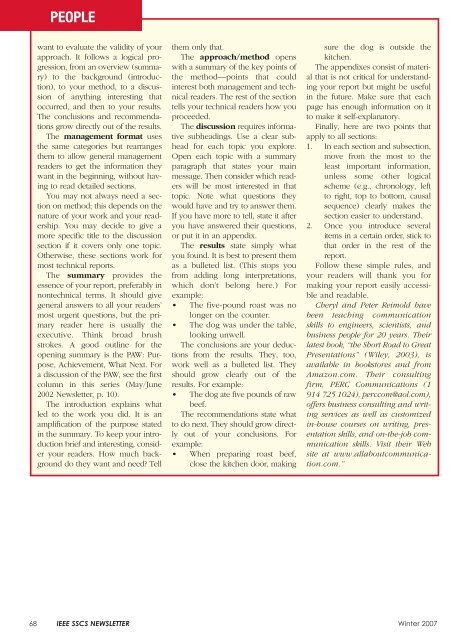The Impact of Dennard's Scaling Theory - IEEE
The Impact of Dennard's Scaling Theory - IEEE
The Impact of Dennard's Scaling Theory - IEEE
- TAGS
- scaling
- www.ieee.org
You also want an ePaper? Increase the reach of your titles
YUMPU automatically turns print PDFs into web optimized ePapers that Google loves.
PEOPLE<br />
want to evaluate the validity <strong>of</strong> your<br />
approach. It follows a logical progression,<br />
from an overview (summary)<br />
to the background (introduction),<br />
to your method, to a discussion<br />
<strong>of</strong> anything interesting that<br />
occurred, and then to your results.<br />
<strong>The</strong> conclusions and recommendations<br />
grow directly out <strong>of</strong> the results.<br />
<strong>The</strong> management format uses<br />
the same categories but rearranges<br />
them to allow general management<br />
readers to get the information they<br />
want in the beginning, without having<br />
to read detailed sections.<br />
You may not always need a section<br />
on method; this depends on the<br />
nature <strong>of</strong> your work and your readership.<br />
You may decide to give a<br />
more specific title to the discussion<br />
section if it covers only one topic.<br />
Otherwise, these sections work for<br />
most technical reports.<br />
<strong>The</strong> summary provides the<br />
essence <strong>of</strong> your report, preferably in<br />
nontechnical terms. It should give<br />
general answers to all your readers’<br />
most urgent questions, but the primary<br />
reader here is usually the<br />
executive. Think broad brush<br />
strokes. A good outline for the<br />
opening summary is the PAW: Purpose,<br />
Achievement, What Next. For<br />
a discussion <strong>of</strong> the PAW, see the first<br />
column in this series (May/June<br />
2002 Newsletter, p. 10).<br />
<strong>The</strong> introduction explains what<br />
led to the work you did. It is an<br />
amplification <strong>of</strong> the purpose stated<br />
in the summary. To keep your introduction<br />
brief and interesting, consider<br />
your readers. How much background<br />
do they want and need? Tell<br />
them only that.<br />
<strong>The</strong> approach/method opens<br />
with a summary <strong>of</strong> the key points <strong>of</strong><br />
the method—points that could<br />
interest both management and technical<br />
readers. <strong>The</strong> rest <strong>of</strong> the section<br />
tells your technical readers how you<br />
proceeded.<br />
<strong>The</strong> discussion requires informative<br />
subheadings. Use a clear subhead<br />
for each topic you explore.<br />
Open each topic with a summary<br />
paragraph that states your main<br />
message. <strong>The</strong>n consider which readers<br />
will be most interested in that<br />
topic. Note what questions they<br />
would have and try to answer them.<br />
If you have more to tell, state it after<br />
you have answered their questions,<br />
or put it in an appendix.<br />
<strong>The</strong> results state simply what<br />
you found. It is best to present them<br />
as a bulleted list. (This stops you<br />
from adding long interpretations,<br />
which don’t belong here.) For<br />
example:<br />
• <strong>The</strong> five-pound roast was no<br />
longer on the counter.<br />
• <strong>The</strong> dog was under the table,<br />
looking unwell.<br />
<strong>The</strong> conclusions are your deductions<br />
from the results. <strong>The</strong>y, too,<br />
work well as a bulleted list. <strong>The</strong>y<br />
should grow clearly out <strong>of</strong> the<br />
results. For example:<br />
• <strong>The</strong> dog ate five pounds <strong>of</strong> raw<br />
beef.<br />
<strong>The</strong> recommendations state what<br />
to do next. <strong>The</strong>y should grow directly<br />
out <strong>of</strong> your conclusions. For<br />
example:<br />
• When preparing roast beef,<br />
close the kitchen door, making<br />
sure the dog is outside the<br />
kitchen.<br />
<strong>The</strong> appendixes consist <strong>of</strong> material<br />
that is not critical for understanding<br />
your report but might be useful<br />
in the future. Make sure that each<br />
page has enough information on it<br />
to make it self-explanatory.<br />
Finally, here are two points that<br />
apply to all sections:<br />
1. In each section and subsection,<br />
move from the most to the<br />
least important information,<br />
unless some other logical<br />
scheme (e.g., chronology, left<br />
to right, top to bottom, causal<br />
sequence) clearly makes the<br />
section easier to understand.<br />
2. Once you introduce several<br />
items in a certain order, stick to<br />
that order in the rest <strong>of</strong> the<br />
report.<br />
Follow these simple rules, and<br />
your readers will thank you for<br />
making your report easily accessible<br />
and readable.<br />
Cheryl and Peter Reimold have<br />
been teaching communication<br />
skills to engineers, scientists, and<br />
business people for 20 years. <strong>The</strong>ir<br />
latest book, “the Short Road to Great<br />
Presentations” (Wiley, 2003), is<br />
available in bookstores and from<br />
Amazon.com. <strong>The</strong>ir consulting<br />
firm, PERC Communications (1<br />
914 725 1024), perccom@aol.com),<br />
<strong>of</strong>fers business consulting and writing<br />
services as well as customized<br />
in-house courses on writing, presentation<br />
skills, and on-the-job communication<br />
skills. Visit their Web<br />
site at www.allaboutcommunication.com.”<br />
68 <strong>IEEE</strong> SSCS NEWSLETTER Winter 2007




